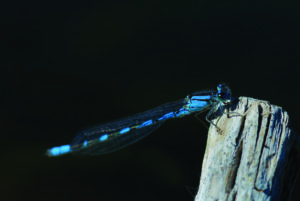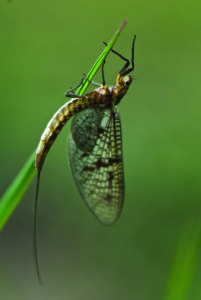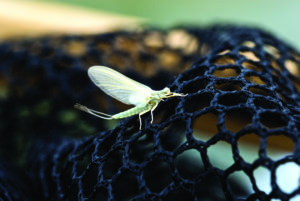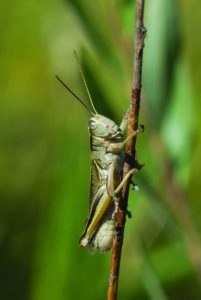The Wood River Valley is a trout lover’s Mecca. Cool, clean water and abundant insect life are the reasons why. Here we profile a few of the region’s most beloved bugs.

Damselfly
Insecta: Odonata
Suborder: Zygoptera
1. Emergence: May – August
2. Life Cycle: Egg, nymph, adult, spinner
3. Location: Riffles, runs and flats in slow moving water
4. Size: 8-12
“If you go out to fish and you don’t take a minute to look around, to listen to the birds and enjoy the view then you are missing so much,” said Phil Crabtree, who’s 73 and still works as a fly fishing guide for Silver Creek Outfitters. “I may be one of the oldest guides on the planet, but I still love it. I live vicariously through my clients. If they catch a fish, I catch a fish and that’s why I keep doing it,” Phil said with an easy smile, adding, “and there’s nothing like catching a fish on a dry fly.”
Damselflies are members of the dragonfly family and are some of the biggest and most striking dry flies (bugs that fish eat off the surface of the water). “We usually fish such small flies so it’s great when the big terrestrials come out. There’s nothing like watching a fish rise to a big fly,” Phil said.
In mid-summer, when the water at places like Silver Creek starts to weed up, the damselflies will hang around the weed pads, while the hungry trout linger along the pads’ edges waiting for them to slip off. “They’re everywhere at some point in the summer and that’s great for someone my age, because they’re easy to see,” Phil joked.
But Phil’s passion for fly fishing and sharing his love for the sport is no joke. “I’m going to keep doing this until I guess I can’t keep doing it,” he said. “I’ve been fishing for eons and I still learn something everyday. I’m lucky enough to be out there.”
-Mike McKenna, author of the award-winning “Gone Fishing” blog on www.sunvalleymag.com

Brown Drake
Genus: Ephemera
Species: Simulans
1. Emergence: June – August
2. Life Cycle: Egg, nymph, adult, spinner
3. Location: Rivers and lakes, predominate in slow water
4. Size: 8-12
There are events in nature that often leave the mind spinning at their grandeur, complexity and enormity. On Silver Creek, one of these events takes place annually. The early summer occurrence of the burrower mayfly known as brown drake goes beyond a “great hatch.” It reaches into the realm of the surreal and perhaps supernatural to anyone, fly angler or not, who witnesses the event.
What makes the brown drake event special is the sheer magnitude of it. Whereas most insects “hatch” and “spin” over the course of weeks and even months, the brown drake completes its life cycle often within 3 to 4 days. The brevity of the event means the insects have to show in numbers rarely seen by people, and coupled with the fact it is normally a dusk to darkness event, even fewer people are treated to the spectacle.
During the “hatch” insects can become so thick on the water’s surface, the bodies and shucks they shed can literally blanket every inch of the river. The fish gorge themselves, often to the point where drakes spill out of their gills as no room is left in their stomachs, but they just keep eating!
Even though the fish are gorging themselves, the fly fishing can be challenging. Sometimes there are just too many choices for the fish as the angler’s fly becomes a needle in a haystack. Whether you fish or not, seeing the brown drake on Silver Creek during the right evening can leave a person reflecting deeply on our natural world. It is an event and migration unparalleled in the state of Idaho, and can leave you with your mouth hanging open, although during the event, it may be best to breathe through your nose!
-John Huber, owner of Ketchum On The Fly

Pale Morning Dun
Genus: Ephemerella
Species: Inermis & Infrequens
1. Emergence: May – August
2. Life Cycle: Egg, nymph, adult, spinner
3. Location: Riffles, runs and flats
in slow-moving water
4. Size: 14-18
For anyone who’s ever cast a fly rod across a cool mountain stream, the term “mayfly” is held in lofty esteem. Simply mentioning the word “mayfly” to a fly fisher almost always elicits a smile. And there’s no better example of a classic mayfly than the Pale Morning Dun (PMD).
“It’s a true mayfly hatch. It starts in May, often in late May, just as the season is starting and goes right through July, usually,” explained Scott Schnebly, arguably the most well-known fly fishing guide in and outside the Wood River Valley. Scott’s been fishing the waters of central Idaho for four decades and owns Lost River Outfitters in Ketchum.
“The first ones are giant, but as the season and summer comes on they get smaller. The fish have been feeding on micro stuff all winter. It’s the first large morsel of the season to eat so they go after them, which makes it great if you’re fishing. Anybody can catch a fish on a PMD in the early season when they’re going off,” he said.
PMDs belong to the crawler group of mayflies. The average hatch lasts for only an hour. The really odd thing about PMDs, according to Schnebly, is that they occasionally all but disappear on places like Silver Creek and the Henry’s Fork of the Snake for a few years, only to reappear as prolific as ever.
Scott’s favorite PMD imitations are Parachute Sulfer and Trim Thorax PMD. He also recommends long leaders and skinny tippet—always. “It’s a handsome fly. It has bright colors and you can see it well. It’s really the bread-and-butter hatch on Silver Creek, and most spring creeks and tailwaters,” Schnebly said.
-Mike McKenna

Grasshopper
Genus: Metaleptea
Order: Orthoptera
1. Emergence: July – September
2. Life Cycle: Egg, nymph, adult
3. Location: Rivers and lakes, especially on windy days
4. Size: 8-14
The strike was so explosive I shrieked like a teen with “Bieber Fever.”
I’d been shaking off fish under 15 inches all afternoon on Silver Creek, and this hog was twice that size. Most days aren’t like that—hell, a lot of years aren’t like that—but last year was one of those special ones.
Local farmers had been warned of a grasshopper plague, and like many fly fishing addicts, I was excited, but had no idea how awesome the fishing really would be. For weeks, I was waist-deep in foam at my fly-tying table and spent as much time on “The Creek” as I could, whether with my clients or friends.
One hot late-summer day, I had my favorite group of ladies on their first day on Silver Creek. We fished tricos in the morning and then I sat them down for a serious discussion about hopper fishing. I had rules—they thought I was crazy—then they saw the fish. It sounded like bowling balls were dropping all around us. I could barely contain my excitement and think the ladies soon caught it, too. They all broke off the biggest trout of their lives, but ended the day in smiles.
I’ve been guiding in the Wood River Valley for five years and I’m still beside myself when I see a fish eat a hopper—either mine or a client’s. Just when I’m getting tired or working too many days in a row, tying on the first hoppers of the summer reinvigorates me for the rest of the season. I’m already shaking just thinking about it and what’s to come.
-Morgan Buckert, fly fishing guide for Sturtevants
WEB EXTRAS: More Fish Food

